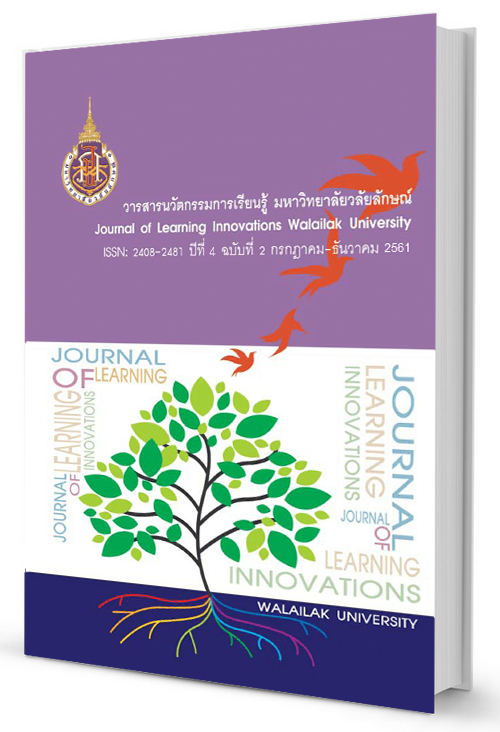ESL Learning Strategy Among Grade Nine Bhutanese Secondary School Students in Chhukha, Bhutan
DOI:
https://doi.org/10.14456/jli.2018.14Keywords:
English as a Second Language, Language Learning Strategies, Strategy Inventory for Language LearningAbstract
This study was to survey the current practice of Rebecca Oxford’s Learning Strategies of grade nine Bhutanese secondary school students in ESL learning and to compare Rebecca Oxford’s Learning Strategies based on gender, age and number of years in ESL learning experience. The researcher employed mixed methods to carry out the study. The IOC of the research instruments were validated by three experts (one from Thailand and two from Bhutan). The quantitative data were gathered from 105 ESL respondents by using the Strategy Inventory for Language Learning (SILL) adapted from Rebecca Oxford (1990) which consisted 50 items, and qualitative data were gathered through focus group discussion which consisted 10 questions from one of the Central schools in Chhukha district. The quantitative data were analyzed using independent sample t-test for gender difference and One-way ANOVA for different age groups and different number of years in ESL learning experience. The qualitative data of the focus group discussion were analyzed using content analysis and the results were tabulated. The findings showed that the majority of the respondents practice metacognitive strategies than social strategies and relatively few were practicing memory, cognitive and affective strategies and the least was compensation strategies. The result showed that the current practice of Rebecca Oxford’s Learning Strategies at the moderate level as indicated by the mean score 3.40 by grade nine Bhutanese secondary school students in ESL learning. The result also revealed that ESL respondents in Bhutanese secondary school students did not have one common Language Learning Strategy suitable for all learners. The study concluded that there was statistically significant difference in use of Oxford’s learning strategies by gender, females employed the strategies most frequently than males.
References
Alhaysony, M. (2017). Language learning strategies use by Saudi EFL students: the effect of duration of English language study and gender. Theory Pract. Lang. Stud. 7, 18–28. doi:10.17507/tpls.0701.03
Al-Qahtani, M. F. (2013). Relationship between English language, learning strategies, attitudes, motivation, and students’ academic achievement. Educ. Med. J. 5, 19–29. doi: 10.5959/eimj.v5i3.124
Arellano, M. D. C. (2017). Memory Learning Strategies in English as a Foreign Language in Vocational Studies. Tendencias Pedagogicas, 299-248.
Baharestani, N., & Zarei, A. A. (2014). Language Learning Strategy use across Proficiency Levels. I-manager’s Journal on English Language Teaching, 4(4), 27-38.
Bhutan Council for School Examinations and Assessment. (2016). Pupil Performance
Report 2017. Volume 10. Thimphu: Bhutan.
Bolukbas, F. (2013). The Effect of Language Learning Strategies on Learning Vocabulary in Teaching Turkish as a Foreign Language. H.U. Journal of Education, 28(3), 55-68.
Charoento, M. (2016). Individual learner differences and language learning strategies. Contemp. Educ. Res. J. 7, 57–72.
Chen, M. L. (2014). Age Differences in the Use of Language Learning Strategies. English Language Teaching, 7(2),144-151.
Curriculum and Professional Support Division. (2005). English Curriculum Framework. Classes PP-XII. Paro, Bhutan: CAPSD.
Dawadi, S. (2017). Language learning strategies profiles of EFL learners in Nepal. Eur. J. Educ. Soc. Sci. 2, 42–55.
Ehrman,M. & Oxford,R. (1990). Adult language learning styles and strategies in an intensive training setting. Modern Language Journal, 74,311-317.
Ehrman,M. & Oxford,R. (1995). Cognition plus: Correlates of Language Learning Success. Modern Language Journal, 79 (1), 67-89.
Green, J. M and Oxford, R. (1995). A closer look at learning strategies, L2 proficiency, and gender. TESOL Quarterly 29(2),261-297.
Griffiths, C. (2013). The strategy factor in successful language learning. Bristol: Multilingual Matters.
Ismail, S. A. A., & Khatib, A. Z. (2013). Investigating the Language Learning Strategies of Students in the Foundation Program of United Arab Emirates University. International Education Studies, 6(9), 135-149.
Kazamia, V. (2010). Using the SILL to record the language learning strategy use: Suggestion for the Greek EFL Population. Advances in Research on Language Acquisition and Teaching, 278-293. Retrieved from https://www.enl.auth.gr/gala/14th/Papers/English% 20papers/Kazamia.pdf
Khamkhien, A. (2010). Factors Affecting Language Learning Strategy Reported Usage by Thai and Vietnamese EFL Learners. Electronic Journal of Foreign Language Teaching,7(1),66-85.
Lham, R. (2011). The Effectiveness of the Implementation of Health and Physical Education Curriculum in Primary Schools of Bhutan. Rangsit University: Graduate School.
Nazri, N.M. (2016). Through the Lens of Good Language Learners: What Are Their Strategies? Advance in Language and Literary Studies, 7(1), 195-202.
Nurmela, J. (2017). The language Learning Strategies of students at a university or applied sciences and how strategy uses correlates with learning success. Retrieved from https://jyx.jyu.fi/bitstream/handle/123456789/56347/URN:NBN:fi:jyu201712154708.pd ? sequence=1.
Oxford R. L. (2016). Teaching and Researching Language Learning Strategies: Self-Regulation in Context. New York, NY: Routledge.
Oxford, R. L. (1990). Language Learning Strategies: What Every Teacher Should Know. Boston, MA: Heinle and Heinle.
Rai,A.,(n.d.). English. Retrieved from https://rec.gov.bt/curriculum-page/section/english/
Saad, N. S. M., & Naif, A. H. (2017). Language Learning Strategies Use and Challenges Faced by Adult Arab Learners of Finnish as a Second Language in Finland. English Language Teaching, 10(4), 111-126.
Sepasdar, M. (2014). The Impact of Age on Using Language Learning Strategies. International Journal of Education & Literacy Studies, 2(3), 26-31.
Uguten,S.D., & Balci, O. (2018). The Relationship between EFL Learners’ Language Learning Strategy Use and Achievement. International Education Studies, 11(2), 1-12.
Wong, L. L. C., and Nunan, D. (2011). The learning styles and strategies of effective language learners. System 39, 144–163. doi: 10.1016/j.system.2011.05.004
Downloads
Published
How to Cite
Issue
Section
License
เนื้อหาและข้อมูลในบทความที่ลงตีพิมพ์ในวารสารนวัตกรรมการเรียนรู้ มหาวิทยาลัยวลัยลักษณ์ ถือเป็นข้อคิดเห็นและความรับผิดชอบของผู้เขียนบทความโดยตรง ซึ่งกองบรรณาธิการวารสาร ไม่จำเป็นต้องเห็นด้วย หรือร่วมรับผิดชอบใดๆ
บทความ ข้อมูล เนื้อหา รูปภาพ ฯลฯ ที่ได้รับการตีพิมพ์ในวารสารนวัตกรรมการเรียนรู้ มหาวิทยาลัยวลัยลักษณ์ ถือเป็นลิขสิทธิ์ของวารสารนวัตกรรมการเรียนรุ้ มหาวิทยาลัยวลัยลักษณ์ หากบุคคลหรือหน่วยงานใดต้องการนำทั้งหมดหรือส่วนหนึ่งส่วนใดไปเผยแพร่ต่อเพื่อกระทำการใดๆ จ้อต้องได้รับอนุญาตเป็นลายลักษณ์อักษรจากวารสารนวัตกรรมการเรียนรู้ มหาวิทยาลัยวลัยลักษณ์ก่อนเท่านั้น


